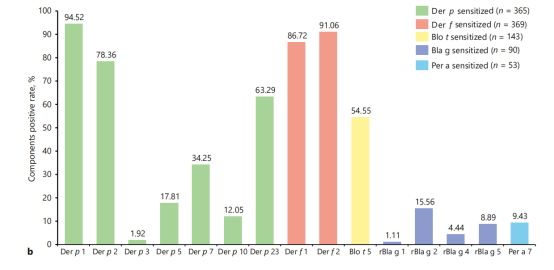Release date:2023-03-13

Int Arch Allergy Immunol
[IF:3.767]
Identifying Potential Co-Sensitization and Cross-Reactivity Patterns Based on Component-Resolved DiagnosisDOI: 10.1159/000504320
Abstract:
Background: Component-Resolved diagnosis (CRD) can help to establish immunoglobulin E (IgE) sensitization profiles and potential risks and determines whether specific IgE is the result of primary sensitization or cross-reactivity, especially for those who are polysensitized.
Methods: We recruited 432 patients with mite-sensitized respiratory allergic diseases to study the co-sensitization and cross-reactivity of the 17 allergen components in Guangdong Province, China, using the CRD method and to describe the potential association between allergen components.
Results: Among the 432 patients, serum specific immunoglobulin E of the 17 components. Der p 1 (81.48%), Der f 2 (77.78%), Der f 1 (74.07%), Der p 2 (66.20%) and Der p 23 (54.63%) were the main sensitized components in patients with mite-sensitized respiratory allergy, while the components of cockroach, crab, and shrimp had a lower positive rate. In the crude extract allergen-positive samples, Der f 2 (91.06%) and Der f 1 (86.72%) were the major sensitized components of Der f, while Der p 1 (94.52%), Der p 2 (78.36%), Der p 23 (63.29%) were the major sensitized components of Der p, and other components of Der p such as Der p 7 (34.25%), Der p 5 (17.81%), Der p 10 (12.05%), Der p 3 (1.92%) were all below 50.00%. Blo t 5 (54.55%) was one of the major components of Blo t. The positive rates of all Bla g components were as follows, rBla g 2 (15.56%) >rBla g 5 (8.89%) >rBla g 4 (4.44%) >rBla g 1 (1.11%). The positive rate of the only available pen a 1 component was 9.43%. Using hierarchical cluster and optimal scale analysis, 17 components can be roughly divided into 5 different sensitization clusters. Also, from the results of the Venn diagram, the allergen component in each cluster has a high proportion of co-sensitization and cross-reactivity. Regardless of age, total IgE levels, and disease type factors, similar sensitization profiles were observed for each component in the same category based on hierarchical clustering analysis.
Conclusion: Epidemiological data on allergen components causing allergic symptoms can be further understood using CRD. Der p 1, Der p 2, Der p 23, Der f 1, Der f 2 as the primary sensitizing component of the study cohort. The positive rate for Blo t 5 was 28.01% for all populations and 54.45% for Blo t-positive samples. In addition, CRD allows us to identify more potential allergen associations such as common sensitivities and cross-reactions between component proteins. Based on these results, we suggest that when patients are identified as sensitized to a particular allergen, clinicians can pay more attention to other allergy components that are closely related to it.
First Author:
Zhifeng Huang
Corresponding author
Baoqing Sun
Correspondence:
Department of Allergy and Clinical Immunology, Guangzhou Institute of Respiratory Health, First Affiliated Hospital of Guangzhou Medical University 151 Yan Jiang Road, Guangzhou, Guangdong 510120 (China)
 杭州浙大迪迅生物基因工程有限公司
杭州浙大迪迅生物基因工程有限公司
